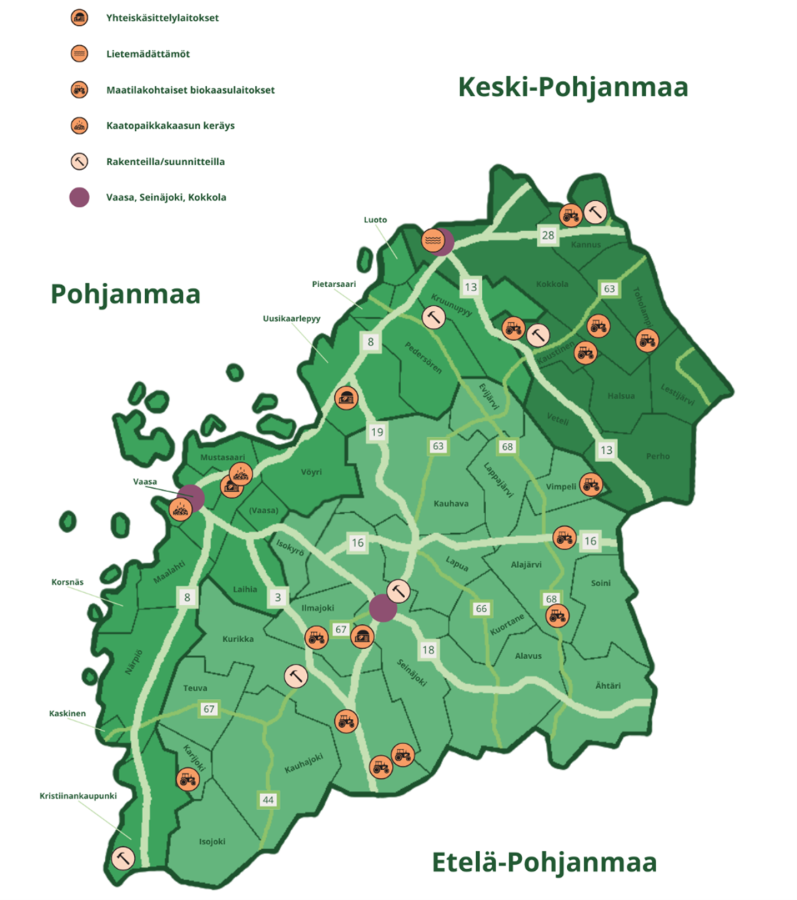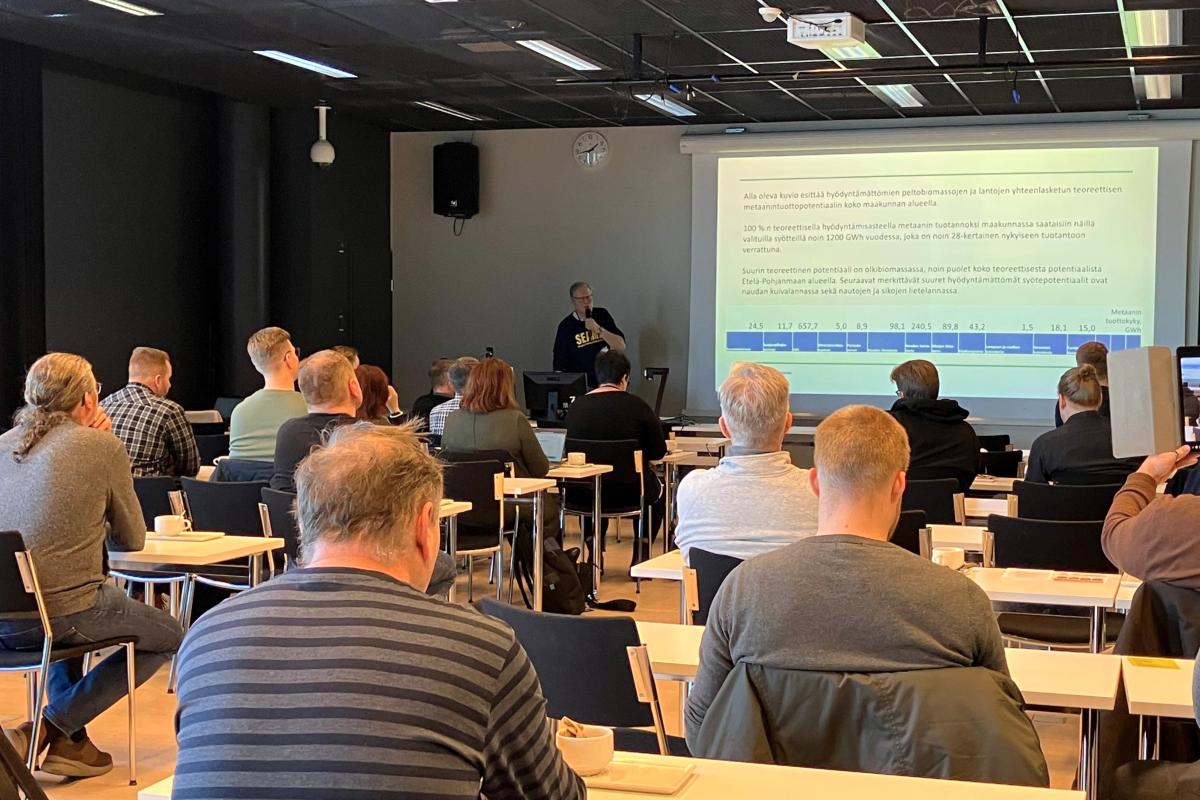Biogas accelerates the green transition in the Ostrobothnian regions – a new digital platform connects operators
Regional clusters have been identified in Ostrobothnia, Central Ostrobothnia and South Ostrobothnia where the production and use of biogas may increase significantly. These biogas concentrations form networks of local actors, such as biogas producers and users, biomass owners and companies providing logistics services. Regional strengths vary in different regions. In Ostrobothnia, development is supported especially by the needs of industry and maritime transport, in Central Ostrobothnia biogas solutions are promoted by an operating environment based on an industrial park, and in South Ostrobothnia the food system creates favourable conditions for the utilisation of biogas. The heavy transport sector is also seen to have growing potential in all regions.
Ostrobothnian regions have a significant opportunity to reduce climate emissions with the help of biogas
The expansion of biogas production offers the Ostrobothnian regions a significant way to reduce climate emissions. The region's combined techno-economic biomethane potential is estimated to be 676–1172 gigawatt-hours per year, which is up to 8 times the current production. Agriculture plays a key role in exploiting this potential, as a large part of the feedstocks, such as manure and plant-based biomasses, are generated by agricultural enterprises.
Particularly significant emission reductions are achieved when manure is used as a raw material for biogas – in this case, the carbon footprint of biogas can even be negative. For example, a plant with an annual input volume of 50,000 tonnes (93% manure, 7% grass biomass) can achieve an emission reduction of up to 135–139% compared to fossil fuels. The use of biogas will reduce emissions from the agricultural sector in particular.
– Biomethane production could be increased to more than a thousand gigawatt-hours per year, while it is currently 140 GWh per year in these three regions. According to our research results, surplus straw can account for up to about half of the biomethane potential in our areas, but there are many challenges associated with its utilisation in practice, says Sanna Hietamäki, Project Manager at SEAMK.
Six new plants are being planned or built in the area, but the production potential is not limited to the borders of municipalities or regions. The location of the feeds in relation to the institutions is essential. Increasing biogas production requires investments, the development of logistics and cooperation between regions.
Fragmentation of regulation and constant changes cause uncertainty
Operators in the biogas sector face many common challenges that limit the growth and cooperation of the sector. Based on the interviews and workshops conducted in the project, the main obstacles are related to the uncertainty of the availability and logistics of raw materials, the lack of market transparency and the complexity of regulation. Producers particularly want long-term contracts and efficient transport solutions, while users want security of supply and clear pricing. Biomass owners, on the other hand, need better tools for managing material flows and incentives to participate in the market.
The fragmentation of regulation and constant changes also cause uncertainty in investment decisions. For example, the EU's climate and circular economy targets, national support schemes and competition legislation set boundary conditions that directly affect operators' opportunities to participate in the market.
– It is clear that we need a common, reliable and transparent digital platform that brings actors together, facilitates the exchange of information and enables more efficient cooperation. Such a solution could not only remove existing obstacles, but also create new opportunities for business development and promoting the green transition, says Wajahat Ali, Project Researcher at the University of Vaasa.
A digital platform as an enabler of a new kind of collaboration
The platform developed in the project serves as both a marketplace and a cooperation network for biogas operators. The goal has been to create an entity that combines biogas trade, feed management, logistics, support services and regulatory information into a single interface. The key future functions of the platform include map-based operator monitoring, competitive tendering of logistics services, bidding and auction functions, and the management of quality and certificates of origin.
Open APIs will be built on the platform, which will enable the platform to be expanded and integrated with other systems. Data security, GDPR compliance, and ease of use have been identified as key design principles that guide the technical specification of the platform. The legal review has also made recommendations, such as the introduction of a code of conduct and clear contract templates, which could support fair competition and clarify cooperation between operators.
– One platform, many opportunities – the digital ecosystem of the biogas sector is built on cooperation, openness and smart integration, says Risto Hietala, RDI Specialist at Centria.
The piloting of the platform has started in stages, and it will be used to test in practice how the planned functions meet the needs of stakeholders. The feedback collected during the pilot will guide further development, and the goal is to build a scalable and long-lasting solution that supports the growth and sustainable development of the biogas market. The DigiBiogasHubs project shows that biogas plays a significant role in the green transition – not only as an energy source, but also as an enabler of regional cooperation and the circular economy.
Further information
Karita Luokkanen-Rabetino, Research Programme Manager, VEBIC, University of Vaasa, karita.luokkanen-rabetino@uwasa.fi, 029 449 8183
The research project DigiBiogasHubs – Flexible and scalable biogas business through digitally connected biogas Hubs is co-funded by the European Union and coordinated by the University of Vaasa research and innovation platform VEBIC. The project partners are Centria and SeAMK. Other funders are Wärtsilä, Stormossen, PK Biogas, the City of Kokkola, the City of Kannus, and the Kaustinen sub-region. The project started in December 2023 and will last for two years.
The information used in the press release is based on the reports produced in the project, which are available on the project's website: https://sites.uwasa.fi/digibiogashubs


